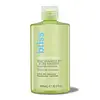What's inside
What's inside
 Key Ingredients
Key Ingredients

 Benefits
Benefits

 Concerns
Concerns

 Ingredients Side-by-side
Ingredients Side-by-side

Water
Skin ConditioningSodium C14-16 Olefin Sulfonate
CleansingPropanediol
SolventCellulose Acetate
Caprylyl/Capryl Glucoside
CleansingAcrylates Copolymer
Coco-Glucoside
CleansingGlyceryl Oleate
EmollientSodium Cocoamphoacetate
CleansingGlycerin
HumectantAloe Barbadensis Leaf Juice
Skin ConditioningCaprylic/Capric Triglyceride
MaskingBenzyl Alcohol
PerfumingCocamidopropyl Hydroxysultaine
CleansingEthylhexylglycerin
Skin ConditioningBisabolol
MaskingHydrolyzed Jojoba Esters
Skin ConditioningSclerotium Gum
Emulsion StabilisingSodium Hydroxide
BufferingRosmarinus Officinalis Leaf Oil
MaskingSalicornia Herbacea Extract
Skin ConditioningTetrasodium EDTA
Lavandula Angustifolia Oil
MaskingCamellia Oleifera Leaf Extract
AstringentAvena Sativa Kernel Extract
AbrasiveWater, Sodium C14-16 Olefin Sulfonate, Propanediol, Cellulose Acetate, Caprylyl/Capryl Glucoside, Acrylates Copolymer, Coco-Glucoside, Glyceryl Oleate, Sodium Cocoamphoacetate, Glycerin, Aloe Barbadensis Leaf Juice, Caprylic/Capric Triglyceride, Benzyl Alcohol, Cocamidopropyl Hydroxysultaine, Ethylhexylglycerin, Bisabolol, Hydrolyzed Jojoba Esters, Sclerotium Gum, Sodium Hydroxide, Rosmarinus Officinalis Leaf Oil, Salicornia Herbacea Extract, Tetrasodium EDTA, Lavandula Angustifolia Oil, Camellia Oleifera Leaf Extract, Avena Sativa Kernel Extract
Water
Skin ConditioningNiacinamide
SmoothingCamellia Sinensis Leaf Extract
AntimicrobialRosa Canina Fruit Extract
AstringentFomes Officinalis Extract
Skin ProtectingCucumis Sativus Fruit Extract
EmollientOryza Sativa Bran Extract
Skin ConditioningAvena Sativa Meal Extract
SoothingHamamelis Virginiana Leaf Water
AstringentSodium Hyaluronate
HumectantGlycerin
HumectantCopper Gluconate
Skin ConditioningMagnesium Aspartate
Skin ConditioningSorbitan Oleate Decylglucoside Crosspolymer
CleansingZinc Gluconate
Skin ConditioningGlycolipids
Skin ConditioningCaprylyl Glycol
EmollientPEG-40 Hydrogenated Castor Oil
EmulsifyingPolysorbate 20
EmulsifyingCaprylyl Glyceryl Ether
CleansingHexylene Glycol
EmulsifyingButylene Glycol
HumectantPropanediol
SolventSodium Phytate
Tetrasodium Glutamate Diacetate
Phenoxyethanol
PreservativeEthylhexylglycerin
Skin ConditioningCitric Acid
BufferingSodium Hydroxide
BufferingWater, Niacinamide, Camellia Sinensis Leaf Extract, Rosa Canina Fruit Extract, Fomes Officinalis Extract, Cucumis Sativus Fruit Extract, Oryza Sativa Bran Extract, Avena Sativa Meal Extract, Hamamelis Virginiana Leaf Water, Sodium Hyaluronate, Glycerin, Copper Gluconate, Magnesium Aspartate, Sorbitan Oleate Decylglucoside Crosspolymer, Zinc Gluconate, Glycolipids, Caprylyl Glycol, PEG-40 Hydrogenated Castor Oil, Polysorbate 20, Caprylyl Glyceryl Ether, Hexylene Glycol, Butylene Glycol, Propanediol, Sodium Phytate, Tetrasodium Glutamate Diacetate, Phenoxyethanol, Ethylhexylglycerin, Citric Acid, Sodium Hydroxide
 Reviews
Reviews

Ingredients Explained
These ingredients are found in both products.
Ingredients higher up in an ingredient list are typically present in a larger amount.
Ethylhexylglycerin (we can't pronounce this either) is commonly used as a preservative and skin softener. It is derived from glyceryl.
You might see Ethylhexylglycerin often paired with other preservatives such as phenoxyethanol. Ethylhexylglycerin has been found to increase the effectiveness of these other preservatives.
Glycerin is already naturally found in your skin. It helps moisturize and protect your skin.
A study from 2016 found glycerin to be more effective as a humectant than AHAs and hyaluronic acid.
As a humectant, it helps the skin stay hydrated by pulling moisture to your skin. The low molecular weight of glycerin allows it to pull moisture into the deeper layers of your skin.
Hydrated skin improves your skin barrier; Your skin barrier helps protect against irritants and bacteria.
Glycerin has also been found to have antimicrobial and antiviral properties. Due to these properties, glycerin is often used in wound and burn treatments.
In cosmetics, glycerin is usually derived from plants such as soybean or palm. However, it can also be sourced from animals, such as tallow or animal fat.
This ingredient is organic, colorless, odorless, and non-toxic.
Glycerin is the name for this ingredient in American English. British English uses Glycerol/Glycerine.
Learn more about GlycerinPropanediol is an all-star ingredient. It softens, hydrates, and smooths the skin.
It’s often used to:
Propanediol is not likely to cause sensitivity and considered safe to use. It is derived from corn or petroleum with a clear color and no scent.
Learn more about PropanediolSodium Hydroxide is also known as lye or caustic soda. It is used to adjust the pH of products; many ingredients require a specific pH to be effective.
In small amounts, sodium hydroxide is considered safe to use. However, large amounts may cause chemical burns due to its high alkaline.
Your skin has a natural pH and acid mantle. This acid mantle helps prevent harmful bacteria from breaking through. The acid mantle also helps keep your skin hydrated.
"Alkaline" refers to a high pH level. A low pH level would be considered acidic.
Learn more about Sodium HydroxideWater. It's the most common cosmetic ingredient of all. You'll usually see it at the top of ingredient lists, meaning that it makes up the largest part of the product.
So why is it so popular? Water most often acts as a solvent - this means that it helps dissolve other ingredients into the formulation.
You'll also recognize water as that liquid we all need to stay alive. If you see this, drink a glass of water. Stay hydrated!
Learn more about Water